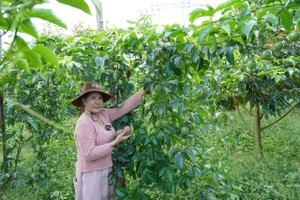
Notably, the digital platform has been playing a key role in helping Vietnamese businesses bring high-quality, unique products under the Vietnamese brand to the global market.
Export products increase sharply
Mr. Phung Quoc Man, Vice Chairman of the Handicraft and Wood Industry Association of Ho Chi Minh City, stated that while traditional export methods for wooden products have significantly declined, the sales of furniture and handicrafts through e-commerce have recorded remarkable growth. According to real-world data, the export turnover for wood products and furniture in the first four months of the year reached US$4.89 billion, an increase of 25 percent compared to the same period last year. The United States remains the largest export market for Vietnamese wood products and furniture, with an estimated turnover of $2.7 billion, up 31.8 percent.
In the agricultural sector, Ms. Tran Thi Ngoc Lan, founder of AnTo Tea Co., Ltd., shared that e-commerce has been creating opportunities for small and medium-sized enterprises (SMEs) to export products under their brands. AnTo, a small enterprise with a charter capital of about VND1 billion, has opted for e-commerce as its export solution. In 2024, the company's Hibiso product has been officially sold on South Korea’s Coupang e-commerce platform. Additionally, Hibiso has signed a contract with Mslinh.com in the Netherlands to facilitate the official export of its products to this market in particular and Europe in general.
“Even though our sales are not yet substantial, we believe that selling agricultural products under Vietnamese brands and establishing a presence on international e-commerce platforms is a strategy for manufacturers to take control of pricing and manage supply and demand,” expressed Ms. Tran Thi Ngoc Lan.
In the textile and garment sector, Mr. Truong Van Cam, Vice Chairman cum General Secretary of the Vietnam Textile and Apparel Association, noted that participating in cross-border e-commerce presents a valuable opportunity for Vietnamese textile enterprises to build their brands. Especially, Vietnam holds a competitive advantage in pricing as a direct producer, and the craftsmanship and quality of its products are highly regarded by importers.
According to a recent report by Access Partnership Analytics on the opportunities for direct export via e-commerce in Vietnam, the country's retail e-commerce exports are projected to reach VND296.3 trillion by 2027. Notably, despite many challenges, Vietnam's e-commerce exports show strong growth potential. Over the past five years (from 2019 to the end of 2023), health and personal care products, home and kitchen items, clothing, and beauty products have consistently been among the fastest-growing categories from Vietnam on the global e-commerce platform Amazon.
“Vietnamese businesses continuously achieve remarkable cross-border export milestones, with the number of businesses reaching annual sales of $1 million on Amazon increasing tenfold in just five years. Not only are they exporting products, but Vietnamese exporters are also investing in brand development for long-term growth,” affirmed Mr. Gijae Seong, Head of Amazon Global Selling Vietnam.
Wide-opened door for Vietnamese products
Market research firms predict that global consumer demand is constantly changing, providing opportunities for certain Made in Vietnam industries to leverage new consumer trends and attract international customers. In the healthcare sector, international preferences are increasingly shifting towards natural and sustainable products. In the wood industry, companies emphasize unique household and home products that are environmentally friendly. In the garment sector, fashion brands should offer reasonably priced, versatile options suitable for both work and leisure.
Mr. Paul Le, Vice Chairman of Central Retail Group, suggests that, with proper and effective utilization, Vietnamese businesses can accelerate global expansion through e-commerce and enhance their international market share. However, according to the overall assessment, the level of engagement in e-commerce export by Vietnamese businesses remains limited, as most companies primarily focus on processing orders and designs from foreign distributors.
To propel Vietnamese products onto the global stage through e-commerce, Ms. Nguyen Thi Minh Huyen, Deputy Director of the Vietnam E-commerce and Digital Economy Agency (iDEA) under the Ministry of Industry and Trade, stated that iDEA is currently implementing a range of initiatives to cultivate the e-commerce market and bolster consumer confidence in e-commerce. "We are collaborating with provincial and municipal governments to execute a series of regional linkage activities aimed at e-commerce development, provide training to enhance State management capacity in e-commerce for localities, support digital transformation efforts for localities and businesses, and promote locally characteristic products on Vietnamese platforms and digital channels," Huyen elaborated.
Furthermore, iDEA is coordinating with Amazon Global Selling to jointly implement the "Industry Collaboration for Cross-Border E-commerce Growth" initiative. This program aims to assist key industry organizations and associations in Vietnam, such as the Vietnam Timber and Forest Product Association, the Vietnam Textile and Apparel Association, and the Handicraft and Wood Industry Association of HCMC, along with numerous other associations and organizations to provide access to skills, knowledge, digital resources, network connections with service providers, and domestic manufacturing units to support production and online export.
























